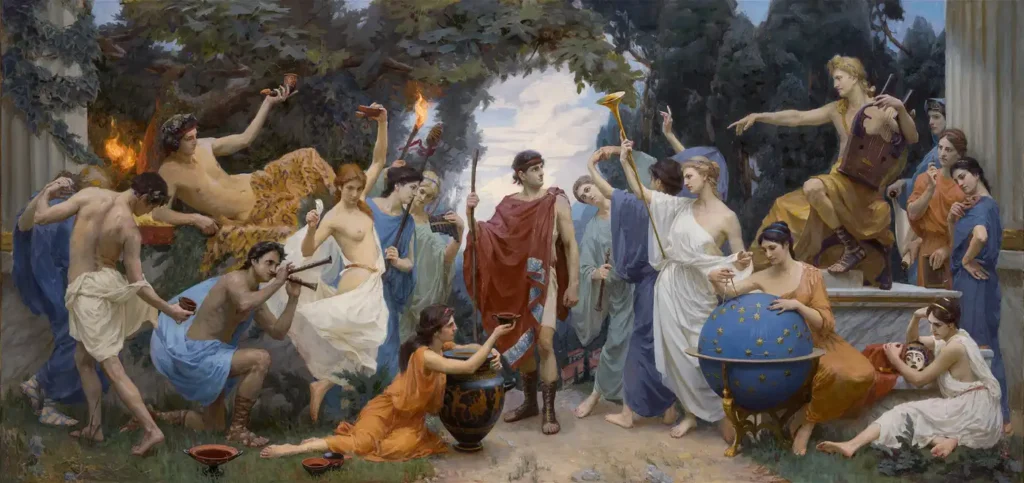The essence of human existence often finds resonance in the interplay of contrasting forces. Friedrich Nietzsche, a towering figure in philosophy, delved deep into this dichotomy through his exploration of the Apollonian and Dionysian principles. These opposing tensions within art, unraveling in the realm of aesthetics, form the cornerstone of Nietzsche’s thoughts, elucidated eloquently in his seminal work, the ‘Birth of Tragedy.’

✅ AI Essay Writer ✅ AI Detector ✅ Plagchecker ✅ Paraphraser
✅ Summarizer ✅ Citation Generator
Who Is Nietzsche?
Friedrich Nietzsche, a 19th-century German philosopher, stands as a pivotal figure in philosophical discourse. His critiques of morality, religion, and culture resonate profoundly in intellectual spheres. Nietzsche’s revolutionary ideas continue to shape modern philosophical thought, rendering him a foundational figure in existentialism and beyond.

What Is the Birth of Tragedy About?
Nietzsche’s ‘Birth of Tragedy’ unfurls as an essay on aesthetics, exploring the core premise that existence finds eternal justification only as an aesthetic phenomenon. This work introduces the profound concepts of the Apollonian and Dionysian principles, portraying them as contrasting artistic paths within ancient Greek tragedy.
Understanding Apollonian and Dionysian Principles
The depth of Nietzsche’s philosophy finds resonance in the exploration of ancient Greek tragedy. These timeless narratives, steeped in the amalgamation of Apollonian and Dionysian elements, serve as exemplary manifestations of Nietzsche’s theories.
Exploring Apollonian Principles
The Apollonian ethos, rooted in the persona of the Greek god Apollo, encapsulates a realm of artistic expression characterized by serene tranquility, logical reasoning, and meticulously structured artistry. Within the Apollonian paradigm, the essence of creation adheres to a sense of order, embracing a world of clarity and defined boundaries. This principle embodies a pursuit of beauty through symmetry, equilibrium, and the imposition of rational structures upon artistic endeavors. It heralds a domain where artistic forms are crafted with precision, evoking a sense of balance and harmony. Apollo symbolizes not only the epitome of rationality but also the embodiment of measured restraint, where artistic creations manifest as serene and poised expressions.
Exploring Dionysian Principles
Conversely, the Dionysian essence, inspired by the enigmatic Dionysus, embodies an artistic realm that transcends conventional norms, embracing emotional depth, ecstatic fervor, and the irrationality inherent in human existence. Within the Dionysian sphere, artistic expression takes a radical turn, delving into the raw, primal aspects of human experience. It encapsulates a world where boundaries dissolve, and emotions surge forth in an unrestrained torrent, fueling a sense of ecstatic liberation. Dionysus embodies the chaotic yet profound elements of existence, urging artistic creation to explore the depths of human emotions and the unbridled forces of nature. Nietzsche’s portrayal of the Dionysian principle heralds a celebration of uninhibited expression, challenging the structured norms of art and beckoning artists to plunge into the depths of emotional intensity and primal unity.

Birth of Tragedy’s Influence on Philosophy and Aesthetics
The dichotomy between the Apollonian and Dionysian extends beyond art to encompass broader philosophical implications. Nietzsche’s philosophical musings revolve around the interplay of these principles, reflecting the essence of human existence and the perpetual struggle between reason and emotion.
The ‘Birth of Tragedy’ not only encapsulates Nietzsche’s thoughts on aesthetics but also serves as a catalyst for broader philosophical discussions. It intertwines the notions of philosophy, aesthetics, and the human condition, presenting a profound inquiry into the nature of existence.
Conclusion
In the intricate tapestry of human experience, Nietzsche’s elucidation of the Apollonian and Dionysian principles stands as a testament to the perpetual tension between opposing forces. The ‘Birth of Tragedy’ not only serves as a foundational piece in aesthetics but also transcends its boundaries to offer invaluable insights into the philosophical intricacies of existence.
In the pursuit of understanding Nietzsche’s philosophy, the exploration of the Apollonian and Dionysian principles offers a gateway to unraveling the complexities of human nature, artistic expression, and the eternal quest for meaning.
FAQ
Follow us on Reddit for more insights and updates.





Comments (0)
Welcome to A*Help comments!
We’re all about debate and discussion at A*Help.
We value the diverse opinions of users, so you may find points of view that you don’t agree with. And that’s cool. However, there are certain things we’re not OK with: attempts to manipulate our data in any way, for example, or the posting of discriminative, offensive, hateful, or disparaging material.